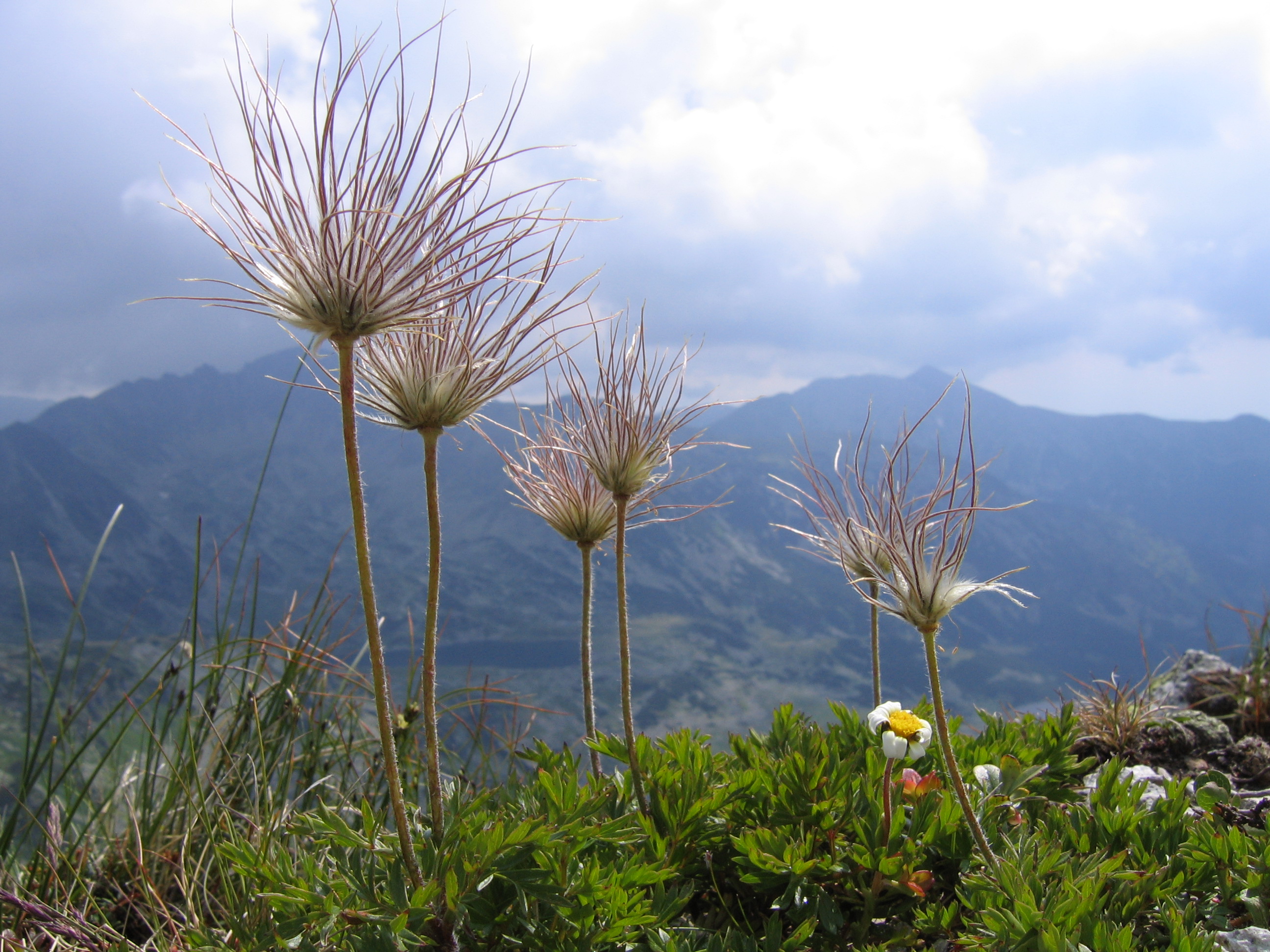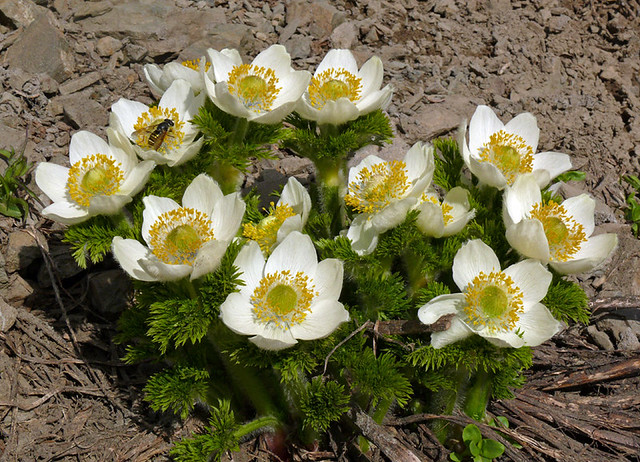Pulsatilla alpina (alpine pasqueflower or alpine anemone) is a species of flowering plant in the family Ranunculaceae, native to the mountain ranges of central and southern Europe, from central Spain to Croatia. It is an herbaceous perennial growing to 15–30 cm (6–12 in) tall by 20 cm (8 in) wide, and can be found at altitudes of 1,200–2,700 m (3,900–8,900 ft).
 Pulsatilla alpina has deeply divided, hairy leaves. It has more upright flowers than other species of Pulsatilla, which generally have drooping flowers. They are white or, in the case of subsp. apiifolia, yellow. The flowers are produced very early, often opening while still under snow cover. They have prominent yellow stamens. As with all pasqueflowers, the flowers have a silky, hairy texture, and are followed by prominent seedheads which persist on the plant for many weeks.
Pulsatilla alpina has deeply divided, hairy leaves. It has more upright flowers than other species of Pulsatilla, which generally have drooping flowers. They are white or, in the case of subsp. apiifolia, yellow. The flowers are produced very early, often opening while still under snow cover. They have prominent yellow stamens. As with all pasqueflowers, the flowers have a silky, hairy texture, and are followed by prominent seedheads which persist on the plant for many weeks.
 A number of subspecies are recognised, based largely on the form and hairiness of the leaves. P. alpina subsp. schneebergensis is endemic to the easternmost Alps of Austria, and is named after the Schneeberg mountain. It is replaced further west by the widespread taxon P. alpina subsp. alpina. P. alpina subsp. austroalpina is found in the Southern Alps from Switzerland eastwards, most commonly over dolomite. P. alpina subsp. apiifolia and P. alpina subsp. alba grow over siliceous rock, but are easily distinguished by the flower colour. Further subspecies have been named for local variants in the Cantabrian Mountains (subsp. cantabrica) and Corsica (subsp. cyrnea).
A number of subspecies are recognised, based largely on the form and hairiness of the leaves. P. alpina subsp. schneebergensis is endemic to the easternmost Alps of Austria, and is named after the Schneeberg mountain. It is replaced further west by the widespread taxon P. alpina subsp. alpina. P. alpina subsp. austroalpina is found in the Southern Alps from Switzerland eastwards, most commonly over dolomite. P. alpina subsp. apiifolia and P. alpina subsp. alba grow over siliceous rock, but are easily distinguished by the flower colour. Further subspecies have been named for local variants in the Cantabrian Mountains (subsp. cantabrica) and Corsica (subsp. cyrnea).
Anemone occidentalis (Western pasqueflower) is a herbaceous plant species in the genus Anemone and family Ranunculaceae. Other authorities place it in the genus Pulsatilla. Individuals are 10 to 60 cm tall, from caudices, with 3 to 6 leaves at the base of the plant that are 3-foliolate, each leaflet pinnatifid to dissected in shape. Leaf petioles are 6-10 cm long.
 Leaves have villous hairs and their margins are pinnatifid or dissected. Plants flower briefly mid-spring to mid-summer, usually soon after the ground is exposed by melting snow. The flowers are composed of 5 to 7 sepals (sometimes called tepals), normally white or soft purple, also mixed white and blueish purple, one flower per stem. The sepals are 15 to 30 mm long and 10 to 17 mm wide. Flowers have 150-200 stamens. The fruit occurs in heads rounded to subcylindric in shape, with pedicels 15 to 20 cm long. The achenes are ellipsoid in shape, not winged, covered with villous hairs, with beaks curved that reflex as they age and 20-40 mm long, feather-like. Generally, the fruit persists into fall.
Leaves have villous hairs and their margins are pinnatifid or dissected. Plants flower briefly mid-spring to mid-summer, usually soon after the ground is exposed by melting snow. The flowers are composed of 5 to 7 sepals (sometimes called tepals), normally white or soft purple, also mixed white and blueish purple, one flower per stem. The sepals are 15 to 30 mm long and 10 to 17 mm wide. Flowers have 150-200 stamens. The fruit occurs in heads rounded to subcylindric in shape, with pedicels 15 to 20 cm long. The achenes are ellipsoid in shape, not winged, covered with villous hairs, with beaks curved that reflex as they age and 20-40 mm long, feather-like. Generally, the fruit persists into fall.
 Native to far western North America including British
Columbia to California and Montana, it is found growing in gravelly soils on slopes and in moist meadows.
Native to far western North America including British
Columbia to California and Montana, it is found growing in gravelly soils on slopes and in moist meadows.
Jeffersonia which is also known as twinleaf or rheumatism root, is a small genus of herbaceous perennial plants in the family Berberidaceae. They are uncommon spring wildflowers, which grow in limestone soils of rich deciduous forests. Jeffersonia was named for United States President Thomas Jefferson, by his contemporary Benjamin Smith Barton. This genus was formerly grouped in genus Podophyllum. Twinleaf is protected by state laws as a threatened or endangered plant in Georgia, Iowa, New York, and New Jersey.
 The leaves and flowers of this plant are smooth and emerge directly from the rhizome at base of the plant. Jeffersonia has showy white flowers with eight petals; the flower resembles Bloodroot. The short-lived flower appears in April or May, before the forest canopy appears (see spring emphemeral). The fruit is a green pear-shaped capsule with a hinged top. The characteristic leaves are large and nearly divided in half, giving rise to its common name, twinleaf. Plants in this genus rarely grow taller than 12 inches (30 cm). As with many other deciduous forest plants, the seeds are dispersed by ants, a process known as myrmecochory.
The leaves and flowers of this plant are smooth and emerge directly from the rhizome at base of the plant. Jeffersonia has showy white flowers with eight petals; the flower resembles Bloodroot. The short-lived flower appears in April or May, before the forest canopy appears (see spring emphemeral). The fruit is a green pear-shaped capsule with a hinged top. The characteristic leaves are large and nearly divided in half, giving rise to its common name, twinleaf. Plants in this genus rarely grow taller than 12 inches (30 cm). As with many other deciduous forest plants, the seeds are dispersed by ants, a process known as myrmecochory.
Dicentra eximia (wild or fringed bleeding-heart, turkey-corn) is a flowering plant with fernlike leaves and oddly shaped flowers native to the Appalachian Mountains. It is similar to the Pacific bleeding-heart (Dicentra formosa), which grows on the Pacific Coast.
 Leaves are finely divided and gray-green, growing from the base of the plant.
Flowers are pink and bloom in tight clusters at the top of leafless, fleshy stems above the leaves from mid-spring to autumn. The four petals are connected at the base. The two outer petals are pouched at the base and bent back at the tips. The inner petals are perpendicular to the outer petals and connected at the tip.
Leaves are finely divided and gray-green, growing from the base of the plant.
Flowers are pink and bloom in tight clusters at the top of leafless, fleshy stems above the leaves from mid-spring to autumn. The four petals are connected at the base. The two outer petals are pouched at the base and bent back at the tips. The inner petals are perpendicular to the outer petals and connected at the tip.
 The pistil is enclosed within the inner petals, and the two stamens are on either side. There are two tiny, triangular, pink sepals above the petals.
Seeds are borne in a plump, pointed pod. They ripen to black while the pod is still green. Each has a white elaiosome prized by ants.
Pacific bleeding-heart (Dicentra formosa) is frequently confused with and sold as Dicentra eximia.
The pistil is enclosed within the inner petals, and the two stamens are on either side. There are two tiny, triangular, pink sepals above the petals.
Seeds are borne in a plump, pointed pod. They ripen to black while the pod is still green. Each has a white elaiosome prized by ants.
Pacific bleeding-heart (Dicentra formosa) is frequently confused with and sold as Dicentra eximia.
Lamprocapnos spectabilis (bleeding heart or Asian bleeding-heart) is a species of flowering plant in the poppy family Papaveraceae, native to Siberia, northern China, Korea and Japan. It is the sole species in the monotypic genus Lamprocapnos, but is still widely referenced under its old name Dicentra spectabilis (now listed as a synonym). It is valued in gardens and in floristry for its heart-shaped pink and white flowers, borne in spring.
Other common names include "Dutchman's breeches", "lyre flower" and "lady-in-a-bath".
 Asian bleeding-heart grows to 120 cm (47 in) tall by 45 cm (18 in) wide. It is a rhizomatous herbaceous perennial with 3-lobed compound leaves on fleshy green to pink stems. The arching horizontal racemes of up to 20 pendent flowers are borne in spring and early summer. The outer petals are bright fuchsia-pink, while the inner ones are white.
Asian bleeding-heart grows to 120 cm (47 in) tall by 45 cm (18 in) wide. It is a rhizomatous herbaceous perennial with 3-lobed compound leaves on fleshy green to pink stems. The arching horizontal racemes of up to 20 pendent flowers are borne in spring and early summer. The outer petals are bright fuchsia-pink, while the inner ones are white.
The flowers strikingly resemble the conventional heart shape, with a droplet beneath - hence the common name. The pure white-flowered 'Alba', somewhat more robust than the species, is a popular cultivar.
The plant sometimes behaves as a spring ephemeral, going dormant in summer.
First plants specimens were introduced into England in the 1840s from Asia by the Scottish botanist and plant hunter Robert Fortune.
There is also a latest legend from Japan which tells a story of how the bleeding heart flower came to be.
 In the story, a young man tried to win the love of a young lady. He did this by giving a pair of rabbits (which are the first two petals of the flower), a pair of earrings (which are the next two petals of the flower), and finally a pair of slippers (which are the last two petals of the flower) to the girl. She continued to reject his affections, and, heart-broken, he pierced his heart with his sword (the middle part of the flower), which caused the bleeding heart.
In the story, a young man tried to win the love of a young lady. He did this by giving a pair of rabbits (which are the first two petals of the flower), a pair of earrings (which are the next two petals of the flower), and finally a pair of slippers (which are the last two petals of the flower) to the girl. She continued to reject his affections, and, heart-broken, he pierced his heart with his sword (the middle part of the flower), which caused the bleeding heart.


